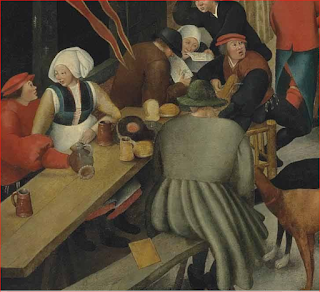It has the expertise from Klaus Ertz, from last year, and on that basis it is firmly said to be by Van Cleve, not even an "attributed to". Logically, as Ertz is the author of a Critical Catalogue of the works of Van Cleve. Nevertheless, I highly doubt this to be a work by Marten Van Cleve, or else it is by far his worst work.
St. George Day, sold at Christie's in 2013 for £750,000
Van Cleve is usually a later follower of Pieter Bruegel, using the same somewhat grayish, earth-toned colouring. Faces are caricatural, arms and legs are geometrical shapes, folds in clothing are avoided were possible or indicated by grey shadows (mainly for robes, not for elbows or knees).Comparing two close-ups makes the difference between the styles (and quality) much more obvious than I can express it in words in the space of a blog.
This work from Sotheby's, from a Follower of van Cleve, sold in 2011 for £37,000, again shows (in a composition comparable to the work for sale) what one expects to find in a work by or after this master. The figures again are caricatural, unrealistic, but lively and much more convincing than the wooden silhouettes in the work offered here. The colouring is completely different, the way things are drawn is incomparable. Both works have in the front a brown-white dog chewing a bone, which is given by Ertz as a typical detail for the master, but similar dogs can be seen in many works by others, like Pieter Coecke.
The Feast of Saint Martin, from the Rubenshuis, shows a more classical, less exuberant and Bruegelian work by Van Cleve. But here as well the typical elements are present, and the quality is lightyears away from what is offered for sale.
I really don't know why Ertz would place this work so firmly with Van Cleve, as it seems a disservice both to the painter and to the critic. It is a poor, run-of-the-mill anonymous work without any redeeming qualities, worth perhaps 2000 Euro.






No comments:
Post a Comment